 As the first generation of DVD-ROM drives ushered in a brand-new day in high-density optical media storage, the same drives seemed to spell doom for die-hard CD-R users, who harbored a well-founded fear that they might have to abandon their investments in CD-R hardware and media and migrate to the new technology.
As the first generation of DVD-ROM drives ushered in a brand-new day in high-density optical media storage, the same drives seemed to spell doom for die-hard CD-R users, who harbored a well-founded fear that they might have to abandon their investments in CD-R hardware and media and migrate to the new technology.
DVD-ROM and CD-R: The Compatibility Question Answered
Hugh Bennett
EMedia Professional, March 1998
As the first generation of DVD-ROM drives ushered in a brand-new day in high-density optical media storage, the same drives seemed to spell doom for die-hard CD-R users, who harbored a well-founded fear that they might have to abandon their investments in CD-R hardware and media and migrate to the new technology. Abandoning the efforts they had already made with CD-R or continuing on with both existing and new technology by means of two separate hardware devices hardly represented an attractive solution.
Given the unique capabilities of CD-R and its established and projected popularity, incompatibility between DVD and CD-R would be unthinkable to most users. Although many first-generation DVD-ROM drives came to market unable to read CD-R discs, astute hardware manufacturers have responded to the concerns of the market and mobilized a tremendous industry effort to ensure that all their current products offer CD-R compatibility. According to Jacques Heemskerk, Program Manager for Philips Electronics NV’s Philips Components, “CD-R is so widely available now you can’t sell DVD-ROM without being able to read it. You really can’t claim to be CD-compatible unless you are CD-R-compatible.”
The same holds true for much-anticipated DVD-RAM drives, which will follow the specification for rewritable DVD approved by the DVD Forum in mid-1997. Although no DVD-RAM drives were shipping at press time, expectations remained high for the new models, a smattering of which are scheduled to ship in the first months of 1998. And since part of that expectation-at least in the minds of DVD-ROM/RAM manufacturers like Toshiba America Information Systems, Inc. and Hitachi America, Ltd.-is for DVD-RAM drives to replace read-only DVD-ROM drives over time, it’s good news that the manufacturers plan to take CD-R along for the ride into high-density rewritable nirvana. DVD-RAM’s triumph is not a done deal at this point, but its proponents are clearly resolved to include CD-R-reading capability in the very first DVD-RAM drives, as are supporters of potential competing specs like DVD+RW when their drives debut.
But whether ROM, RAM, or RW, the message issued with the second wave of DVD-ROM drives will hold true for some time: CD-R’s got a future with DVD.
MAKING DVD CD-R-SAFE: THE TWO-LASER SOLUTION
Since CD-R discs were never designed to be read at wavelengths shorter than 780nm-and certainly not at the 650nm wavelength used for DVD-Philips Electronics in 1996 originally proposed that the solution to the compatibility problem was to create a new type of upwardly-compatible CD-R Type II disc capable of being read at both 780nm and 650nm wavelengths. But developing CD-R Type II proved a formidable technical challenge. Describing his company’s efforts to develop a CD-R Type II disc, Taiyo Yuden, Inc. general manager for new product planning Tad Ishiguro says the company “found that it was not difficult to achieve the specification proposed by Philips at 650nm by changing organic dye components or introducing phase change material. However, it was extremely difficult to maintain the recordability and playability with all the CD-R recorders and CD players in the market.”
As a result of the technical problems and runaway success of existing CD-R, the idea of a Type II disc was abandoned in 1997 in favor of a plan to create DVD-ROM drives capable of generating both 780nm and 650nm wavelengths for reading both DVD and CD-R. As the technological obstacles have been overcome, most major DVD drive manufacturers have chimed in with CD-R-reading DVD-ROM drives that net the same result, but are achieved through a handful of different technological strategies. Sony Electronics, Inc., for example, uses two distinct optical pickups to read 780nm CD-R discs and 650nm DVD-ROM discs, while Samsung pioneered the single-lens, double-duty method with its first dual-read DVD-ROM drive. Others taking the CD-R/DVD-ROM-compatible drive plunge are key DVD players Toshiba, Hitachi, and Matsushita Electronic Industrial Corporation.
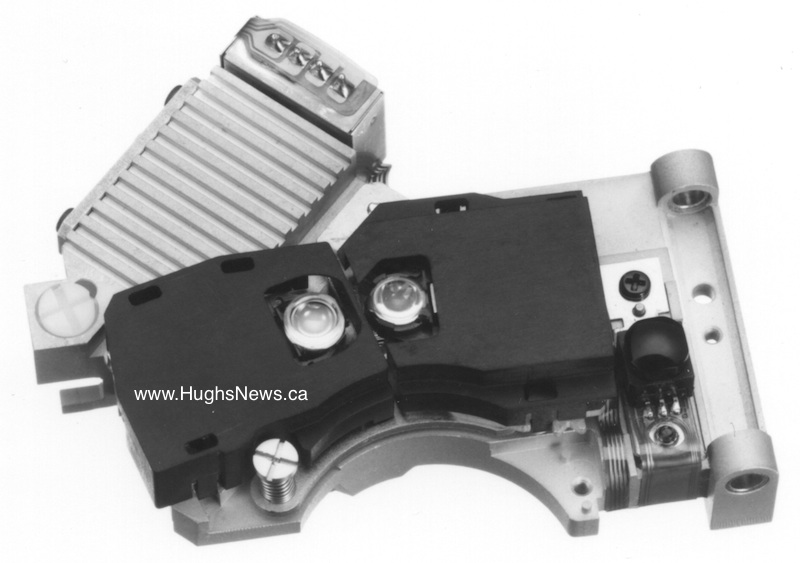 Sony Electronics: The First Paired Pickups
Sony Electronics: The First Paired Pickups
Without a doubt, the company that took the lead in the area of CD-R hardware compatibility was Sony Electronics. In July 1996, Sony announced two twin-laser CD-R-compatible DVD optical pickups, the KHS-180A, offering 635nm and 780nm wavelengths, and the KHS-180B, employing 650nm and 780nm wavelengths.
Formally dubbed the “Dual Discrete Optical Pickup,” the new pickups achieve backward-compatibility with existing CD and CD-R discs using a two semiconductor design that joins Sony’s existing 8X 780nm laser coupler with either a 635nm or 650nm pickup. Except for the objective lens, the laser coupler integrates all the components of a single-beam 780nm pickup (photo detector, micro prism, 780nm laser diode, and integrated circuit) into a tiny bundle small enough to be fastened to the larger DVD pickup. And for dealing with the unique characteristics of DVD discs, the pickup employs a discrete DVD optical system with its own components (photo detector, objective lens, collimator lens, beam splitter, 635 or 650nm laser diode) and separate light path.
Sony also has the honor of being the first hardware company to ship a CD-R-compatible DVD-ROM drive. As well as reading CD-R and other compact disc formats using Sony’s “Dual Discrete Optical Pickup,” the company’s DDU-100E is a single-speed DVD-ROM drive that offers eight-speed CD-ROM drive performance, an ATAPI interface, and tray-loading design.
In addition to its pioneering efforts on the DVD-ROM front, Sony is the only manufacturer currently offering DVD-Video players that are capable of reading CD-R discs. Introduced in April 1997 as a high-end DVD reference player, the $1,000 DVP-S7000 incorporates Sony’s “Dual Discrete Optical Pickup” for playing both CD-R and pressed CD-Audio and Video CDs. With hardware prices continuing to fall, it is encouraging to note that Sony has retained the dual-laser pickup for its more consumer-oriented DVD player, the $599 DVP-S3000, which was introduced in October 1997.
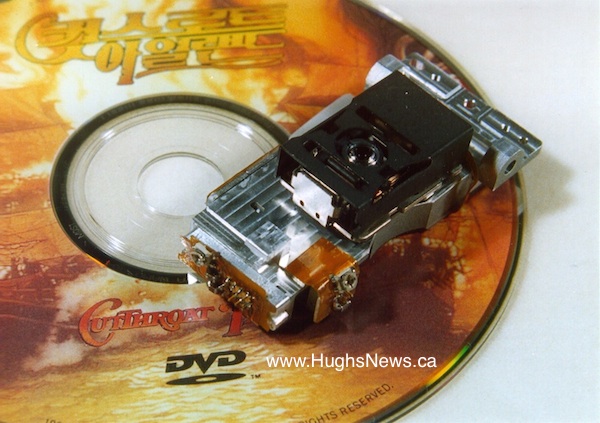 Samsung Electronics: Two Lasers, One Lens
Samsung Electronics: Two Lasers, One Lens
The second company to develop a CD-R-compatible DVD optical pickup was Korean giant Samsung Electronics, which announced its achievement in December 1996. Proving again that there are many ways of approaching and solving technical problems, Samsung’s solution exemplifies a direction many other manufacturers have taken in their own product designs.
Unlike Sony’s solution, which employs discrete CD and DVD optical systems and light paths, Samsung’s pickup uses a single shared objective lens for both CD and DVD wavelengths. Equipped with 780nm and 650nm laser diodes, the pickup uses a largely shared light path and an annular masked objective lens to compensate for the different substrate thicknesses and to provide the correct numerical aperture for reading both families of discs.
The first commercial fruit of Samsung’s efforts is the SDR-130 DVD-ROM drive, which includes CD-R read capability, 1X constant linear velocity (CLV) DVD-ROM reading, and 8X CLV speed when functioning as a CD-ROM drive. Samsung also continues the use of its innovative pickup in the drive’s successor, the SDR-230 DVD-ROM drive, which was announced at COMDEX in November 1997. Like most second-generation DVD-ROM drives, the SDR-230 is fully CD-R compatible and boasts 2X CLV DVD-ROM and 20X constant angular velocity (CAV) CD-ROM performance.
Toshiba Corporation: R/ROM/RAM, READ/READ/REWRITE
Although Toshiba Corporation’s initial DVD-ROM offerings could not read CD-R discs, CD-R has now been fully embraced in the second generation of products, which include not only DVD-ROM, but the initial DVD-RAM drives expected to ship sometime in early 1998 as well. Toshiba’s SD-M1102 for desktop PCs offers 2X max CAV DVD and 24X max CD-ROM drive performance; the SD-C2002 17mm slimline model also brings DVD and CD-R compatibility to notebook computers with 2X max CAV DVD and 16X max CD-ROM speeds.
Since DVD-RAM proponents like Toshiba intend for rewritable DVD drives to replace read-only DVD hardware, rather than coexist in a separate bay in the computer, Toshiba’s recently announced-but still-unshipped at press time – DVD-RAM drive meets the same stringent demands placed upon DVD-ROM drives to read most disc formats. In addition to rewriting 2.6GB/ side cartridged DVD-RAM discs, Toshiba’s SD-W1001 SCSI and SD-W1002 ATAPI DVD-RAM drives read all DVD and CD formats.
Toshiba also manufactures optical pickups for most of its DVD products. A distinct unit is used for each drive model, including a standard size, a slimline unit with reduced size and weight for notebooks, and one with sufficient power for rewriting. As in Samsung’s design, Toshiba’s pickups employ a single optic system with separate 650nm and 780nm laser diodes for providing the correct wavelength light for each disc family. Adjusting the numerical aperture of the lens is accomplished by a special coating around the lens’ circumference, which is opaque at a light frequency of 780nm, but completely transparent at 650nm. When 780nm light is used, the coating restricts the numerical aperture of the lens to 0.45, but since the coating is transparent to 650nm light, the numerical aperture is increased to its full 0.6 extent when reading DVDs.
The pickup to be used in forthcoming DVD-RAM also has the ability to write 2.6GB DVD-RAM discs, which requires additional space. Unlike read-only pickups, which house the laser diodes together with the rest of the elements, Toshiba’s DVD-RAM pickup mounts the 650nm diode on the drive’s chassis to dissipate heat more effectively.
Although the precise method and algorithms CD-R-compatible DVD-ROM drives use for determining which type of disc is present in the drive, most begin by trying to obtain basic focus and tracking by initially assuming a 0.6mm DVD substrate thickness. If the read succeeds, the drive continues at 650nm; if it fails to obtain focus and training, the 780nm light path is called into use. After focus and tracking have been established, the drive reads the identification information encoded on each disc and selects the appropriate gain settings needed for the discs’ reflectivity.
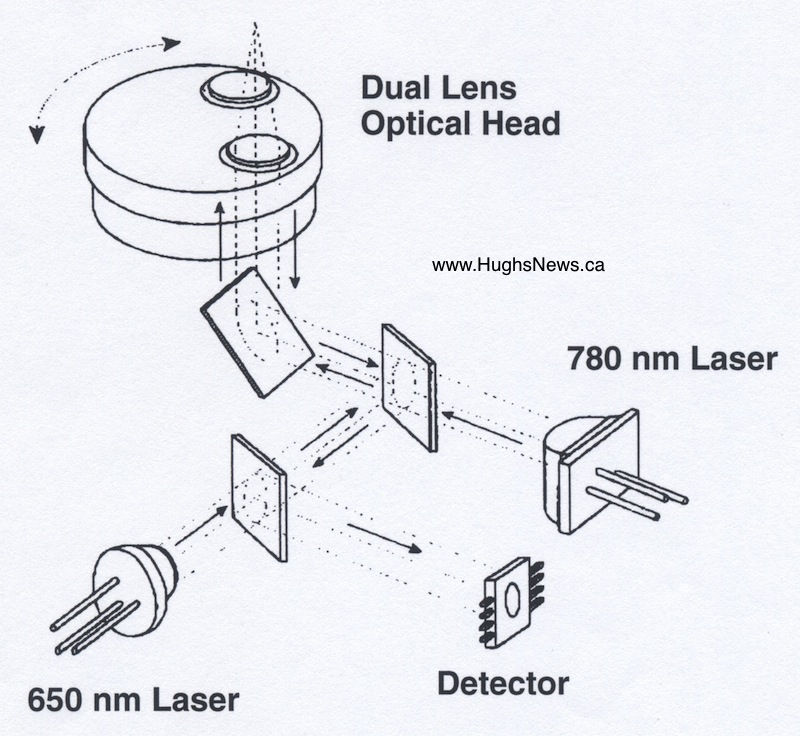 Hitachi America: Dual Reading for DVD-ROM and RAM
Hitachi America: Dual Reading for DVD-ROM and RAM
One of the more prominent members of the DVD Forum, Hitachi America offers DVD-ROM drives capable of reading CD-Recordable discs; the company says forthcoming DVD-RAM will feature CD-R compatibility as well. The currently shipping GD-2000 DVD-ROM drive offers 2X CLV DVD read performance and 20X CAV speed when reading compact discs. [See Hugh Bennett, “Hitachi’s GD-2000 DVD-ROM Drive,” EMedia Professional, February 1998, Volume 11, Number 2.] Hitachi’s first-generation GF-1000 ATAPI and GF-1050 SCSI DVD-RAM drives, expected to begin shipping in early 1998, also read all formats.
To overcome the wavelength obstacle in dealing with CD-R media and to provide full backward-compatibility, Hitachi has engineered an ingenious optical pickup solution consisting of separate 780nm and 650nm laser diodes, as well as a circular head containing two objective lens. Depending upon the type of media inserted, the drive uses the correct wavelength laser needed and swivels the head to position the appropriate objective lens in the laser light path. Hitachi indicates that the company uses the same optical pickup design for both DVD-ROM and DVD-RAM drives.
Matsushita/Panasonic: New Phase, Same Phase-Change
Manufactured by the Matsushita Kotobuki Electronics (MKE) division of Matsushita Electric Industrial Co., and sold under the Panasonic brand name, the SR-8183 slimline model for notebooks and SR-8582 half-height model drives are Matsushita’s first DVD-ROM drives capable of reading CD-R discs.
Matsushita’s optical pickup design merges old and new technology by employing a new single objective lens, dual focus optics, a 650nm laser diode, polarizing hologram for increased light efficiency, and the company’s existing Phase Change Dual (PD) optical pickup, which provides the correct 780nm wavelength light source and supporting components to enable the drive to read any compact disc format.
Matsushita’s Optical Disc Systems Division (ODSD) which is also responsible for the company’s PD products, says it will also offer CD-R read compatibility in its LF-D100 SCSI and LF-D111 ATAPI DVD-RAM drives, which were not shipping at press time, but are due to be released in first quarter 1998. Using a different integrated optical head with two objective lenses, the LF-D100/D111 uses one lens and the 780nm light path to read all compact discs and the other lens and 650nm light path not only to read and write 2.6GB DVD-RAM discs, but also to read and write 650MB PD cartridges as well.
THE CD-R-EVOLUTION IN DVD-ROM: A WIN/WIN FOR MANUFACTURERS AND USERS
As dual-read technology advances through various approaches, such as Sony’s dual discrete, Samsung and Toshiba’s single optic systems, Hitachi’s rotating head strategy, or Matsushita’s PD-incorporating perk, the number of manufacturers offering CD-R-compatible DVD products continues to grow. Today, several additional companies are planning CD-R-compatible DVD-ROM models, including LG Electronics, Mitsumi, Philips, and Pioneer, and others are very likely to follow. Even members of the alternative rewritable DVD+RW format group have publicly pledged that when their drives come to market, their hardware will have CD-R capability; since Philips and Sony – the key developers of CD-R – are backing DVD+RW, CD-R/DVD+RW compatibility should come as no surprise.
The arrival of CD-R read compatibility as a standard feature in today’s DVD-ROM drives is a real optical technology triumph, especially considering CD-R/DVD compatibility’s uncertain beginnings. Now, however, it is clear that hardware manufacturers have met the challenge and should be congratulated for their success. By removing the compatibility barrier to the adoption of DVD, both CD-R and DVD hardware and media sales will benefit tremendously and existing CD-R users will no longer feel betrayed by a new technology that at first appeared willing to write them off.
Reading Mixed Media: A History of the Conflict
To understand the compatibility problem that complicates reading CD-R discs with DVD-ROM drives requires a working knowledge of the ways in which CD, DVD, and CD-R media are constructed and read.
In general terms, conventional “pressed” compact discs are made up of an optical stack consisting of an injection-molded polycarbonate plastic substrate with a spiral track of variable length pits and lands that physically encodes all the data contained in the disc. Over the substrate is a thin aluminum or gold reflective layer, which is covered by an outer protective lacquer coating.
CD-ROM drives retrieve the information by focusing a low-powered, 780nm infrared laser beam onto the spiral data track. The height difference between the pits and lands causes destructive interference, the reflected beam modulating from 30 percent to 70 percent the intensity of the light returned to a photo diode detector. The photo diode detector then converts the reflected light into a high-frequency signal, which is used for tracking and focusing the laser beam, controlling the disc’s speed, and decoding the stream into usable data.
Although replicated DVDs use the same basic principle, there are substantial physical differences between molded plastic CDs and DVDs that make it difficult to accommodate reading both using the same drive. For example, DVDs use a substrate half as thick as a CD, as well as smaller pits and lands and less distance between the spirals of the data track. DVDs are read using a much shorter wavelength laser-red 650/635nm instead of infrared 780nm-and use a lens with a larger numerical aperture. Numerical aperture is a measurement of the pickup’s light-gathering ability.
First-generation DVD-ROM drives employed a number of innovative and successful solutions for reading both types of discs, but were incompatible with CD-Recordable media due to additional divergences in how the different media are made and what they’re made from. Although CD-R discs share the same basic differences as current molded plastic CDs from molded DVDs, CD-Rs have the added difference of a wavelength-sensitive organic dye recording layer.
CD-Recordable media operates under a different principle than molded discs. Instead of using the physical height change of a plastic pit to disperse light, a CD-R disc uses an organic dye that has been changed by the recording laser to create areas or “marks” of decreased “reflectivity.” These marks mimic the light-scattering effects of molded pits and provide a result optically close enough to a conventional compact disc so the CD-R disc can be read by any CD-ROM drive or CD player.
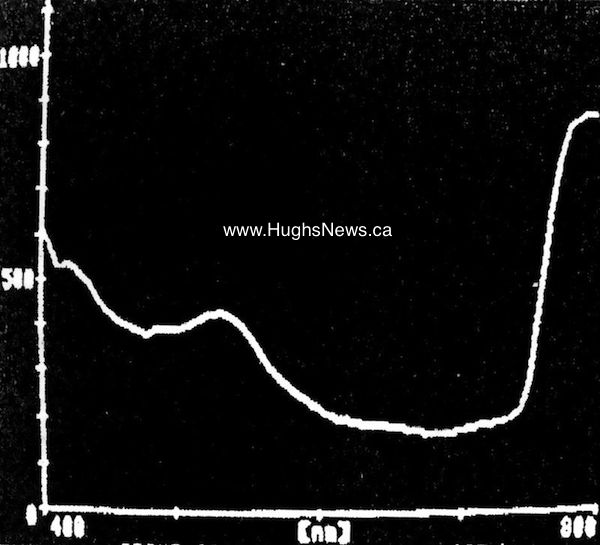
The spectral wavelength response (from 400 to 800nm) of the ungroved portion of one brand of CD-R disc.
However, unlike molded plastic pits, the optical responses of the organic dyes used in CD-R media are critically wavelength-dependent and have a high light absorption below the very narrow range surrounding 780nm. This means that the high reflectivity and optical response necessary to read the disc is extremely difficult to reproduce when using the shorter, 650nm DVD wavelengths.
For example, CD-R discs have a reflectivity greater than 65 percent when read with an infrared 780nm laser, but only have approximately 10 percent reflectivity when read with the 650nm red laser specified by DVD. This difference results in the loss of necessary contrast between pits and lands for critical tracking signals and reliable information retrieval.
According to Tad Ishiguro, General Manager for New Product Planning at Taiyo Yuden, “even at 10 percent reflectivity, the eye pattern from ours and several brands of CD-R discs is not too bad, so data could probably be extracted. However, even though a few hardware companies tell us that it is physically possible to play back such media,” he continues, “they say it is extremely difficult to support every brand available.”
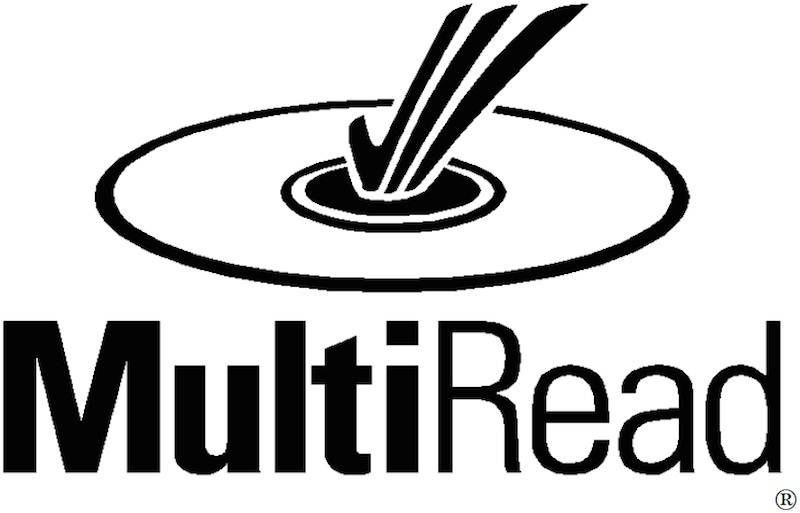 MultiRead: Look for It
MultiRead: Look for It
Being able to identify easily the capabilities of a DVD-ROM drive at point of purchase can be difficult. Most consumers are not accustomed to scrutinizing detailed specification sheets and sales staff are not always well-informed. Something as specific as checking for CD-R compatibility can easily get lost in the shuffle.
One way to provide a clear definition to the public of a drive’s capabilities is by having consumers look for an identifying logo or term on the box or in advertising that captures complex concepts. “MultiRead” is such a helpful term.
Created by the Optical Storage Technology Association (OSTA), a prominent manufacturers’ and industry group that promotes the use of writable optical technology, MultiRead is a drive specification defining the logical and physical requirements of a drive that can read CD-ROM, CD-DA, CD-R, and CD-RW discs. Any DVD-ROM drive bearing the MultiRead logo or displaying the name MultiRead provides assurance that the unit reads CD-R discs.
The OSTA CD-R/DVD-ROM Compatibility Study
Since 1995, the CD Writable Physical Compatibility subcommittee of OSTA has undertaken a program of compatibility testing for CD recorders, media, and readers. The current effort by the group is a CD-R/DVD-ROM compatibility study designed to help manufacturers assess the ability of their DVD-ROM drives to read CD-R discs.
Fourteen hardware companies are participating in the study, including Acer Peripherals, Hitachi, JVC, LG Electronics, Matsushita Kotobuki, Mitsubishi Electric, NEC Home Electronics, Philips, Pioneer, Samsung, Sanyo, Sony, and TEAC. The framework for the tests involves having DVD-ROM drives read a representative sample of fully-written 74-minute CD-R discs taken from an earlier OSTA compatibility study, as well as one pressed CD-ROM containing the same data set. Both the CD-R and CD-ROM media are played in the manufacturer’s DVD-ROM drive to measure such parameters as average access time, average transfer rate, and read time, in addition to optional data verification and average error rates.
The first round of testing is scheduled for completion in February 1998, followed by a formal report. Preliminary results presented at the OSTA meeting in San Jose, California on October 21, 1997, indicated relative success. More than 70 percent of the CD-R discs displayed an average access time within 10 percent of that of the pressed disc. Additionally, more than 90 percent of the CD-R discs arrived at an average data transfer rate within 10 percent of that of the pressed disc. Since many of the products used at that time were still in development, the final results are expected to become significantly better as market-ready products are evaluated.
Companies Mentioned in This Article
Eastman Kodak Company
343 State Street, Rochester, NY 14650-5019; 800/235-6325; Fax 716/253-7179; http://www.kodak.com
Hitachi America, Ltd.
Computer Division, 2000 Sierra Point Parkway, MS: 500, Brisbane, CA 94005-1835; 800/448-2244, 650/589-8300; Fax 415/244-7647; http://www.hitachi.com
LG Electronics U.S.A.
1000 Sylvan Avenue, Englewood Cliffs, NJ 07632; 201/816-2000; Fax 201/816-0636; http://www.goldstar.co.kr
Mitsumi Electronics Corporation
4655 Old Ironsides Drive, Suite 130, Santa Clara, CA 95054; 408/970-0700; Fax 408/727-5337; http://www.mitsumi.com
Optical Storage Technology Association (OSTA)
311 East Carrillo Street, Santa Barbara, CA 93101; 805/963-3853; Fax 805/962-1541; http://www.osta.org
Panasonic Computer Peripheral Company
Two Panasonic Way, Secaucus, NJ 07094; 800/742-8086, 201/348-7000; Fax 201/392-4792; http://www.panasonic.com
Philips Professional Solutions
3200 North First Street, San Jose, CA 95134; 408/570-5600; Fax 408/570-5700; http://www.philips.com
Pioneer New Media Technologies, Inc.
2265 East 220th Street, Long Beach, CA 90801-1720; 310/952-3022; Fax 310/ 952-2990; http://www.pioneerusa.com
Samsung Electronics America, Inc.
Information Systems Division, 105 Challenger Road, Ridgefield Park, NJ 07660; 201/229-4000; Fax 201/229-4110; http://www.sosimple.com
Sony Electronics, Inc.
3300 Zanker Road, MD: SJ2A2, San Jose, CA 95134-1901; 408/432-1600; Fax 408/955-5111; http://www.sony.com
Strategic Marketing Decisions
61 East Main Street, Suite C, Los Gatos, CA 95032; 408/395-5159; Fax 408/395-1569
Taiyo Yuden (USA), Inc.
Arlington Center, 714 West Algonquin Road, Arlington Heights, IL 60005; 800/368-2496; Fax 847/870-7828
Toshiba America Information Systems, Inc.
Disk Products Division, 9740 Irvine Boulevard, Irvine, CA 92713-9724; 714/457-0777; Fax 714/583-3133; http://www.toshiba.com
About the Author
Hugh Bennett, editor-in-chief of Hugh’s News, is president of Forget Me Not Information Systems, a reseller, systems integrator and industry consultant based in London, Ontario, Canada. Hugh is author of The Authoritative Blu-ray Disc (BD) FAQ and The Authoritative HD DVD FAQ, available on Hugh’s News, as well as Understanding Recordable & Rewritable DVD and Understanding CD-R & CD-RW, published by the Optical Storage Technology Association (OSTA).
Copyright © Online Inc. / Hugh Bennett